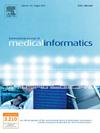Using longitudinal data and deep learning models to enhance resource allocation in home-based medical care
IF 3.7
2区 医学
Q2 COMPUTER SCIENCE, INFORMATION SYSTEMS
International Journal of Medical Informatics
Pub Date : 2025-04-26
DOI:10.1016/j.ijmedinf.2025.105953
引用次数: 0
Abstract
Background
The aging population is driving increased healthcare demands and costs, prompting the need for effective home healthcare programs. Accurate patient assessment is essential for optimizing resource allocation and tailoring services.
Objective
This retrospective study explores the application of artificial intelligence (AI) in predicting home medical care stages to enhance care delivery.
Methods
Data from Taipei City Hospital (2015–2021) included inpatient, outpatient, and home medical care records. Three deep learning (DL) models—Transformer encoder-based, long short-term memory (LSTM), and gated recurrent unit (GRU)—were compared with three baseline machine learning (ML) models. Models were trained on 3, 5, and 10 consecutive visits for binary and multiclass classification. Performance was evaluated using accuracy, precision, recall, and the area under the receiver operating characteristic curve (AUC).
Results
The study included 4,343 patients with a mean age of 85.04 ± 11.47 years. While models trained on 10 visits generally exhibited higher performance, data from 5 visits were sufficient for accurate predictions. With five visits, the LSTM model achieved the highest AUC (0.908) for distinguishing between the absence (S0) and presence (S1–S3) of home medical care. Meanwhile, the Transformer achieved the best AUC (0.86) for classifying S0–S3, with individual stage AUCs of 0.90, 0.82, 0.81, and 0.94 for S0, S1, S2, and S3, respectively.
Conclusions
AI deep learning models show strong potential for accurately predicting home medical care stages. The best-performing model could be a promising tool for healthcare professionals to optimize resource allocation in home medical care settings.

利用纵向数据和深度学习模型优化居家医疗资源配置
人口老龄化正在推动医疗保健需求和成本的增加,促使人们需要有效的家庭医疗保健计划。准确的患者评估对于优化资源分配和定制服务至关重要。目的探讨人工智能(AI)在家庭医疗护理阶段预测中的应用,以提高护理服务质量。方法台北市立医院2015-2021年住院、门诊和家庭医疗记录。三种深度学习(DL)模型——基于变压器编码器、长短期记忆(LSTM)和门控循环单元(GRU)——与三种基线机器学习(ML)模型进行了比较。模型分别在3次、5次和10次连续访问中进行二分类和多分类训练。使用准确度、精密度、召回率和接收者工作特征曲线下面积(AUC)来评估性能。结果共纳入4343例患者,平均年龄85.04±11.47岁。虽然经过10次访问训练的模型通常表现出更高的性能,但5次访问的数据足以进行准确的预测。在5次访问中,LSTM模型在区分家庭医疗护理缺失(S0)和存在(S1-S3)方面的AUC(0.908)最高。同时,Transformer对S0 - S3的分类AUC最高(0.86),S0、S1、S2和S3各阶段AUC分别为0.90、0.82、0.81和0.94。结论深度学习模型在准确预测家庭医疗护理阶段方面具有很强的潜力。表现最好的模型可能是一个有前途的工具,为医疗保健专业人员优化资源分配在家庭医疗护理设置。
本文章由计算机程序翻译,如有差异,请以英文原文为准。
求助全文
约1分钟内获得全文
求助全文
来源期刊

International Journal of Medical Informatics
医学-计算机:信息系统
CiteScore
8.90
自引率
4.10%
发文量
217
审稿时长
42 days
期刊介绍:
International Journal of Medical Informatics provides an international medium for dissemination of original results and interpretative reviews concerning the field of medical informatics. The Journal emphasizes the evaluation of systems in healthcare settings.
The scope of journal covers:
Information systems, including national or international registration systems, hospital information systems, departmental and/or physician''s office systems, document handling systems, electronic medical record systems, standardization, systems integration etc.;
Computer-aided medical decision support systems using heuristic, algorithmic and/or statistical methods as exemplified in decision theory, protocol development, artificial intelligence, etc.
Educational computer based programs pertaining to medical informatics or medicine in general;
Organizational, economic, social, clinical impact, ethical and cost-benefit aspects of IT applications in health care.
 求助内容:
求助内容: 应助结果提醒方式:
应助结果提醒方式:


